
The Arena from above, as it was seen in Series 5-7. Note the Floor Spinner/Disc of Doom (in front of Brutus Maximus) which was only used between Series 6 and Extreme 2
The Series 5-7 Robot Wars Set was the fifth incarnation of the Robot Wars Arena, designed by Julian Fullalove who had designed the previous arena. It was first used in the first series of Robot Wars Extreme and Robot Wars: The Fifth Wars, as well as Season 1 of Robot Wars: Extreme Warriors and Series 1 of Dutch Robot Wars. All the aforementioned series were filmed at Elstree Studios, while Season 2 of Extreme Warriors and Nickelodeon Robot Wars were later filmed at Shepperton Studios. All subsequent series were filmed at RAF Newton, starting with Series 6.
The Series 5-7 arena was similar to the one used in Series 4, but differed in many ways. It weighed a total of 15,000kg, and the arena floor took eight men a full day to prepare. The base was made out of 6-inch reinforced steel.
General Description
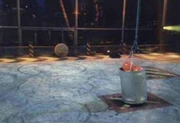
The arena being prepared
As with the previous arena, the set consisted of a large plywood square surrounded by a wall made from bulletproof glass, which had been heightened from the previous year. The arena exterior remained largely the same as in Series 4, save from the balcony, which was replaced by a large central compartment which linked the two booths. The large Robot Wars logo, almost the only surviving remnant of the original arena, was also replaced by a large sliding door with the Robot Wars logo painted onto it. This door was used as an entrance for the House Robots, the two doors on either side were used as competitor entrances.
Hazards
This incarnation of the arena featured few changes to its hazards compared to Series 4. Nevertheless, there were noticeable differences from the Series 4 incarnation by the time the show came to its twelve-year hiatus:
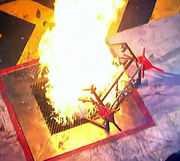
The Spider burns over the Flame Pit
- The arena now featured fewer flame hazards, with the wall-mounted flamethrowers being removed and replaced by upward-firing flame jets that lined the central entry gate. The flame jets and Flame Pit were disabled and altered for the recording of Nickelodeon Robot Wars, the latter spouting jets of CO2 for that series only. While the flame hazards would rarely cause visible damage, they still had the potential to create major internal damage, set flammable robots alight, or even immobilise competitors that stood on them for too long, such as The Spider and Pinser.
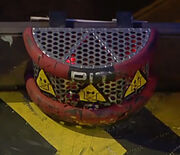
The pit release button as it appeared in Series 6
- The Pit of Oblivion remained the arena centrepiece, painted in yellow and black hazard stripes and lined with a red border. Unlike in previous series, competitors could activate the pit by pressing the pit release button, which either took the form of a yellow tyre (Extreme 1/Series 5, Extreme 2-onwards), or a metal bumper (Series 6 only). As in Series 4, the pit's descent was heralded by a siren, and a smoke plume would go off if a competitor fell in.
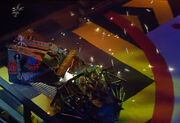
Dead Metal attacks X-Terminator in the CPZ in Extreme 2
- The Corner Patrol Zones (CPZs) remained present in the corners of the arena, painted in yellow and black hazard stripes with red borders. From Extreme 1 onwards, only two House Robots were featured in the arena at one time, patrolling their CPZs and attacking competitors if they strayed too close to them as before.
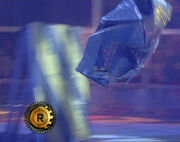
The Floor Flipper thrusts Judge Shred 2½ into the air
- The Floor Flipper retained the design it received in Series 4, but received substantial upgrades that made it more capable of throwing robots across the arena. In every series from Series 5/Extreme 1 onwards, it gradually became more powerful until it was almost capable of throwing heavyweight competitors out of the arena, as demonstrated in the Series 7 battle between S.M.I.D.S.Y. and Mean Streak. Even so, it was able to throw featherweights completely out of the arena from time to time.
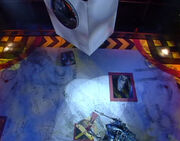
Sir Killalot (bottom) places Robochicken onto the Drop Zone
For Series 6, two new hazards were introduced to the arena:
- The Drop Zone was a large black square with a yellow cross, where defeated competitors would have objects dropped onto them from the arena ceiling when they were placed onto the square. Originally planned to be introduced for Series 5, it first appeared in Extreme Warriors Season 2 and Nickelodeon Robot Wars, and would be used for Series 6-7, the second series of Dutch Robot Wars and Robot Wars Extreme, and German Robot Wars. Various different objects were dropped, ranging from electrical appliances such as washing machines and televisions, to assortments of balls, car parts and even ocean buoys. The Drop Zone was originally planned to be activated by a button similar to those used for the pit and Floor Spinner, but this idea was not implemented.Citation?
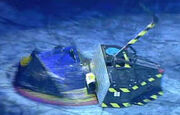
Lightning and Nasty Humphrey spin on the Floor Spinner
- The Floor Spinner (also known as the Disc of Doom) was a circular-shaped spinning panel built into the floor, similar to the Spinners used in the American robot combat show BattleBots. The hazard was introduced in Extreme Warriors Season 2 and made its UK debut in Series 6, intended to fling competitors across the arena whenever they drove over it, interfering with their manoeuvrability. The Floor Spinner was activated by a button similar to the pit release button, and varied in design and speed between series. In practice, the Floor Spinner rarely proved effective, and was removed at the end of Extreme 2. Some robots such as Firestorm and Dantomkia also got their wedges stuck underneath the Spinner, posing another flaw with the hazard.
- Other hazards introduced to the series included wall-mounted Angle Grinders and floor-mounted CO2 Jets/Steam Vents. The Angle Grinders were intended to slice into other robots upon contact with them, while the CO2 jets were self-explanatory, firing jets of CO2 from the arena floor. While they were rarely effective, many competitors would get stuck on angle grinders if they were wedged against or flipped on top of them, while a CO2 jet once immobilised Tetanus by seeping through a gap in the latter's bottom armour.
Arena Perimeter

Craig Charles presents from the central booth
The perimeter of the Series 5-7 arena received minor tweaks and cosmetic upgrades after Series 4. Notable changes included the change of backdrop from the military submarine feel in Series 4 to one giving the the impression of an abandoned factory.
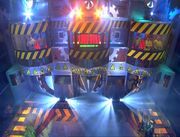
The revised front façade, booths and balcony
Additionally, most of the balcony area was closed off and replaced with a central booth, from which Craig Charles and the hosts of the international series would talk to the camera during introductions and when announcing the results of almost every battle. From this area, competitors would enter and exit their control booths, and leave to the bullpens where robots were loaded, prepared for combat, and collected for transit back to the Pits at the end of each battle. From the central booth, the hosts would also interview competitors at the end of each battle in all versions, solving the space issues noticeable in Series 4. TV monitors were also fitted to the competitors' control booths, usually to either display images of their robots in the background, or give them another view of the battle.
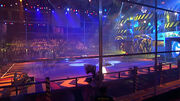
The audience overlook the arena during Series 5
Safety continued to play a major factor in the design of the arena, with the audience being protected by the arena wall, a flip out zone, an outer plexiglass case and a crowd control barrier in front of the seating areas. The arena wall was also upgraded to be made out of 18mm bulletproof macralon, although robots such as Hydra and Typhoon 2 were notable for destroying sections of the wall during the course of Series 7. This often resulted in battles being stopped for safety reasons in order to carry out repairs to the wall.
- "Wasn't great at series 7. Curved polycarbonate distorted things slightly. The solid band across the centre was a pain in the arse if you would at the closest end of the arena and you had to hold your transmitter at a funny high angle because of the long 40 meg aerials (not an issue these days with 2.4gig).
Oh and the lights made everything VERY warm" - — Gary Cairns, on the Series 7 control booths
Changes from the Previous Series

The Arena being built
- The balcony was replaced by a roofed booth similar to the competitors' control booths.
- The static and retractable spikes on the walls were removed.
- Angle Grinders were introduced to replace the static wall spikes.
- The power of the Floor Flipper was considerably improved.
- The flamethrowers on the front wall were replaced with vertical-firing flame jets located either side of the centre entry gate.
- Only two House Robots were used per battle, except for the House Robot Rebellions.
- The Pit Release button was introduced.
- The Drop Zone was introduced from Series 6 / Extreme Warriors Season 2 onwards.
- The Floor Spinner/Disc of Doom was introduced in Series 6 / Extreme Warriors Season 2, but removed after Extreme 2.
| ||||||||||||||||||||||||||
